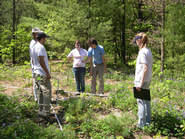
The Frosted Elfin is not much to look at. It is a small, brownish butterfly whose unspectacular markings help it blend in against the backdrop of bark and dead leaves and grasses in its natural habitat in the Rome Sand Plains. The elfin, however, is an essential part of a fragile ecosystem and its numbers, recently, are decreasing. Five Hamilton students—Dan Bruzzese ’12, Eddie Williams ’12, Jonathan Pinney ’11, Chloe Von Ancken ‘11 and Mary Lehner ’12—along with Associate Professor of Biology Bill Pfitsch, are spending the summer doing field work for a project called “Restoration Ecology of Common Blue Lupine in the Rome Sand Plains” to find out why the frosted elfin is disappearing and how to get it back.
Not many people know that wildfires often perform essential ecosystem functions. Wildfires are almost always associated with destruction and devastation, but in many ecosystems, they’re perfectly natural and even valuable, in moderation. Wildfires, or rather a lack of them, could actually hold the answer to the decline of the Frosted Elfin in the Rome Sand Plains because the elfin is dependent on an early-successional plant, the Blue Lupine, whose own growth is contingent on occasional brushfires.
Back before there were settlers in Oneida County, the Rome Sand Plains was an area of rich biodiversity. Periodic wildfires in the plains used to clear much of the wildlife and set the pattern of ecological succession (where certain plant growth serves to pave the way for growth of new species) back to square one. In this ecosystem, where the only tree to gobble up sunlight was the fire-resistant Pitch Pine, the Blue Lupine, a flowering plant and member of the pea family, thrived. In many cases, success for the Blue Lupine meant success for the Frosted Elfin, because the elfin requires the lupine for reproduction.
Unfortunately for the Frosted Elfin, settlers in the Rome Sand Plains reacted unfavorably to the wildfires and sought to end them altogether. The end of wildfires meant the end of the dominance of early-successional plants, and the Rome Sand Plains slowly transformed into a more wooded ecosystem where the dense White Pine outcompeted the Pitch Pine, eating up the sunlight that used to be available for lupine growth.
Pfitsch and his research students are measuring various factors in different areas of the Rome Sand Plains to see which conditions the Blue Lupine responds best to. Their work consists of counting individuals of certain species, measuring light density, and running lab tests on soil samples to determine the soil chemistry. They hope to be able to combine this information with knowledge of lupine populations and eventually determine the factors under which the lupine performs at its best.
The students see their research as being an effort in wildlife conservation to return, as best they can, the Rome Sand Plains to the conditions that existed before humans started interfering. They also impressed that this research is an important exercise in realizing how humans are affecting the natural world. Eddie Williams noted that prevention of wildfires is something that most people think of as being 100 percent beneficial, but ever our smallest, seemingly inconsequential actions can have profound effects on an ecosystem, and it’s important to be conscientious of that.
Not many people know that wildfires often perform essential ecosystem functions. Wildfires are almost always associated with destruction and devastation, but in many ecosystems, they’re perfectly natural and even valuable, in moderation. Wildfires, or rather a lack of them, could actually hold the answer to the decline of the Frosted Elfin in the Rome Sand Plains because the elfin is dependent on an early-successional plant, the Blue Lupine, whose own growth is contingent on occasional brushfires.
Back before there were settlers in Oneida County, the Rome Sand Plains was an area of rich biodiversity. Periodic wildfires in the plains used to clear much of the wildlife and set the pattern of ecological succession (where certain plant growth serves to pave the way for growth of new species) back to square one. In this ecosystem, where the only tree to gobble up sunlight was the fire-resistant Pitch Pine, the Blue Lupine, a flowering plant and member of the pea family, thrived. In many cases, success for the Blue Lupine meant success for the Frosted Elfin, because the elfin requires the lupine for reproduction.
Unfortunately for the Frosted Elfin, settlers in the Rome Sand Plains reacted unfavorably to the wildfires and sought to end them altogether. The end of wildfires meant the end of the dominance of early-successional plants, and the Rome Sand Plains slowly transformed into a more wooded ecosystem where the dense White Pine outcompeted the Pitch Pine, eating up the sunlight that used to be available for lupine growth.
Pfitsch and his research students are measuring various factors in different areas of the Rome Sand Plains to see which conditions the Blue Lupine responds best to. Their work consists of counting individuals of certain species, measuring light density, and running lab tests on soil samples to determine the soil chemistry. They hope to be able to combine this information with knowledge of lupine populations and eventually determine the factors under which the lupine performs at its best.
The students see their research as being an effort in wildlife conservation to return, as best they can, the Rome Sand Plains to the conditions that existed before humans started interfering. They also impressed that this research is an important exercise in realizing how humans are affecting the natural world. Eddie Williams noted that prevention of wildfires is something that most people think of as being 100 percent beneficial, but ever our smallest, seemingly inconsequential actions can have profound effects on an ecosystem, and it’s important to be conscientious of that.
Posted June 24, 2010
